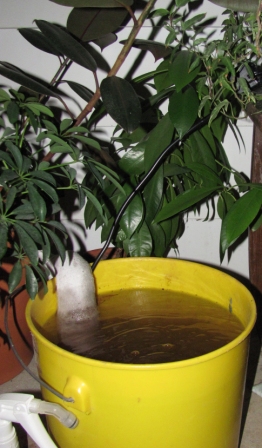In terms of efficiency, it’s hard to beat an organism that gets by with a single cell. The word “Bacteria” could use some good press. It’s usually seen in the media following a suggestion to kill 99% of it. After living through a decade of this fear based advertising I could likely yell “bacteria” in a crowded theater to cause a panic. In reality, a very small percentage of bacteria pose any threat to a healthy person. Most bacteria are harmless and some bacteria are downright helpful. Compost tea is a method of turning these mini helpers into a self perpetuating source of goodness for your plants.
Compost tea can be applied directly to the soil as a soak, used as a foliar spray, or both. The organism rich mixture helps plants process nutrients, suppress disease, speed up the breakdown of toxins, and results in vegetables with an increased nutritional value. As a foliar spray compost tea has been shown to inhibit black spot and powdery mildew while repelling aphids, spider mites, and plant parasitic nematodes. It offers a little something for everything that ales the indoor winter garden.

Before I go too much further down the road of how great bacteria is, I should note that a generation of hand sanitizing citizens was not born out of a completely unfounded fear. There are some really bad apples in this bunch. Always wear gloves when working with soil, compost, or compost tea. Wash your hands when you’re done. I prefer not to use composted manure of any sort. This is especially true for edible plants as the manure increases the chance of dangerous pathogens. Never use the tea on edible seedlings. Putting a stop to spraying edible plants 90 to 120 days before harvest is a good extra precaution.
Making compost tea is simple and ranges from inexpensive to free depending on what you have on hand. First, you need an empty container that will hold water and isn’t metal. A five gallon bucket or a jug (ideally opaque) works. Then, you’ll need worm castings or other finished compost. If you don’t have your own or you aren‘t certain it’s mature, you can find compost (worm castings are best) in most places that carry garden supplies. Next, you’ll need water. Rainwater or distilled water is best but most tap water is fine if you let it sit out over night before you use it. Finally, you need aeration; a highly oxygenated solution will encourage the good bacteria to reproduce quickly and eliminate most of the pathogenic (bad) bacteria. Recirculation or a couple small aquarium pumps will likely do the trick. The aeration should be enough to cause a slight churning of the water.
Add 1 part compost to every 10-50 parts water. To avoid the filtering step you can add the compost to a porous bag to seep like tea. This can be anything from a pillow case to an old sock. It helps to hang the compost filled bag so that there is room for the aeration below it in the water. Check that the container is well aerated and just let it brew. Twelve to 24 hours at room temperature is about right. Cold temperatures can slow down the process.
There should be no foul smell in finished tea. If it smells bad, it’s not finished. Turn off the aerator or recirculation system, pull out your compost, and let the particles settle for about 20 minutes. The process will result in a liquid rich not only in beneficial bacteria, but helpful fungi, protozoa, nematodes, and nutrients. You are ready to fill your sprayer or water can. Compost tea is past its prime after about 4 hours. The good bacteria and other organisms start running out of air very quickly so it’s best to apply immediately. Tea can be diluted if there isn’t enough to go around or you can have a whole new batch within 24 hours. Chalk one up on the side of good, for our little bacterial helpers.
Angela Lundmark enjoys gardening outdoors and indoors and freelance writer.
Related Articles & Free Email Newsletter
Early Growth Fertilizer Regiments for Propagation & Vegetative Stages




Comment here